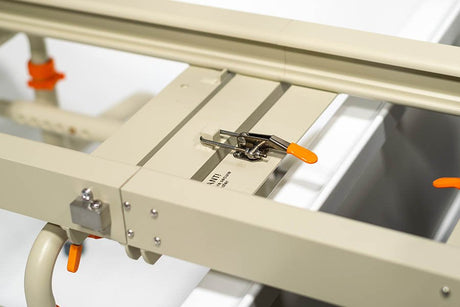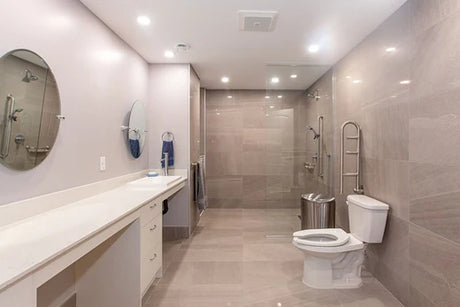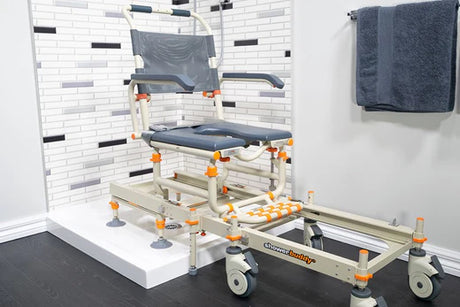Thanks to our experience in this space, we’re able to share with you five common criteria that any shower chair worth its salt should offer the user – and their carer. This isn’t an exhaustive list, but certainly gives you a good starting point to research from.

1. Adjustability
Finding an option that instead offers a degree of adjustment in the feet rests, seated position, arm rests, height and even seated angle helps the equipment to become far better a support tool than those models without. Adjustability allows carers to modify the experience to suit the mobility impaired individual, and make changes on the fly as needed. They also help the chair work easier with a given bathroom configuration.
Depending on the level of mobility support needed, the adjustments may not need to be extensive – but some basic configuration can really help.
2. Sturdy build quality
As you look for shower chairs, make a point of finding out about the components and how the whole package has been assembled. In the low cost homeware store options, corners are cut everywhere to bring them under a certain price point. And while there are basic safety thresholds products must meet, the ability for these low cost chairs to withstand the realistic rigours of everyday use and still perform as intended is questionable.
Consider for a moment an individual with little to no personal mobility control. Perhaps they are 6 foot tall and 95kg – a shower stool must be able to easily accommodate any typical size of person through being loaded, unloaded and during bathing.
Some of the telltale signs of poor build quality can be found when inspecting the fittings and machining tolerances. Mass produced, low quality shower chairs will often show signs of poor accuracy in welds, joins and in the condition of screws and bolts. It’s not enough to simply look for a particular type of material; there are different grades of steel, aluminium, plastic and vinyl. There’s a lot of difference between material designed for hospital grade application and something found at a homeware store.

3. Resistance to rust
It’s hard to know just by looking at a shower chair if you’ll have problems with rust. That’s why you’ll want to look into the specifications of the product to see if the metals used are graded and denoted as anti-rust. For example, Showerbuddy’s frames are No rust Aluminium frames (Grade 6061 T6).
4. Supportive during bathing
In your shower chair purchase, you’ll want to check for a number of elements that provide the user support you should expect:
- Does the seat provide ample cushioning to the user?
- Is the seat keeping the user secure from slipping whilst sitting down bathing?
- Are there armrests?
- Can the armrests adjust to suit the preferences of the user?
- Is there a reliable backrest?
- Does the chair offer feet rests to allow the user to bathe without any reliance upon the bathtub or shower unit?
- Is there an available seat belt to keep the user in place securely?


5. Enables ease of transfers in and out of the shower
Then there’s a category of shower mobility equipment often referred to as a ‘shower transfer bench’. These apparatus intend to make the access to the shower a bit easier for someone with a carer to be slid across the edge of the unit – or for those with good upper body strength to use solo. Their design is like that of a bench with half the unit outside of the bath, and the other half inside. The problem is that despite a comparative high price versus basic shower chairs, they don’t take the manual strain off the transfer which is where many of the accidents occur. These units also commonly have poor quality seats as this is a secondary design concern after the flat bench.
The challenge then becomes finding a shower chair that offers easy and secure transfers inside and out of the tub, and operates effectively as a shower chair whilst bathing. That narrows down the list of choices quite a bit.
Where to find shower chairs that meet this criteria
Consider not simply showering but ‘bathroom mobility’ in general. That’s exactly what the Showerbuddy range of bathroom mobility chairs are designed for. Solutions for bathtubs, shower units and open plan showers are catered for throughout the range. Explore the full range and the features they provide.
Further reading
IEnjoyed this article? You may be interested in these resources online:
- Shower Chairs – our complete guide
- 6 Common Issues With Poor Quality Shower Chairs – Showerbuddy blog
- Securing NDIS Funding For Bathroom Mobility – Showerbuddy blog


























![Toilet Training A Young Child With Mobility Challenges [And How A Shower Chair Can Help]](http://shower-buddy.com/cdn/shop/articles/toilet-training-disabled-child_520x500_a90e5234-d372-435d-aa56-8da15dd3836c.webp?v=1722557239&width=460)
























